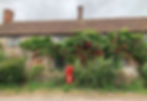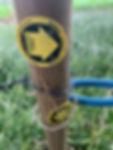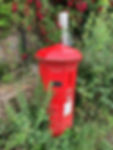Bishop’s Caundle – Home to the UK’s oldest postbox (but a most unwelcoming place to visit)
4 min readBishop's Caundle is a small village in rural North Dorset, the sort of place where you expect pretty walks in the countryside and a good...
Bishop’s Caundle is a small village in rural North Dorset, the sort of place where you expect pretty walks in the countryside and a good village pub for a refreshing drink afterwards. Home to a unique British icon, an early Victorian postbox which is still in use, you would think this would make for a good walk with a bit of history thrown in. Sadly, this is not the case.

One thing you will notice when trying to plan a visit to the village of Bishop’s Caundle is that there is a significant shortage of walks on offer in guidebooks or on the internet. We should have realised there was a good reason behind this, but a look at the OS map had shown that there were plenty of public footpaths available, so we took a risk, thinking maybe it was just so off the beaten path that no one had put anything online as yet.
There is nowhere to park in the village but we ended up at the Village Hall which although it was closed, had a small car park. A sign informed us that parking was for patrons only, but with no other options available, that’s where we ended up, feeling a bit uncertain but hoping people would understand.
We had mapped out a circular route from the village hall to take us through some countryside to the country’s oldest postbox and back again, using public rights of way. However, although the footpaths were clearly marked on the map, that did not seem to correlate with the real world.

The signs show access, the wires do not
The first one we tried was behind a locked gate which we had to climb, and the path had been planted with crops. We walked round the edge of the field, so as not to damage to crops, but they had actually been planted right up to the edge. Every turn we took, assured by the map it was a public footpath, we found that the farmer had put up gates, fences, wires to block paths and that much of the signage had been removed.
Where we did find signage, assuring us we were on the right track, wires had been strung across the path, leaving us very uncertain if a farmer was going to come charging out yelling at us to “get off his land”. Most of the footpaths that we ended up on were so overgrown that it was impossible to see any sort of path at all. We tripped and stumbled over brambles, nettles were up to head height, our clothes got ripped and we ended up covered in scratches and bruises.
Spot the footpaths…
This was not just a fresh season of minor growth. This was years worth of neglect. We couldn’t open gates because they were so overgrown. We had to hunt around for ages to try and find the paths – we could see the signs but there was just no access. In the end, we managed to get ourselves onto the road and gave up entirely on the footpaths. However, the roads are very narrow and very bendy; it was a hazardous experience with lots of cars having to break suddenly as they rounded the corner and saw us. We did our best to leap out of the way, but the verges too were overgrown and full of potholes, causing us further injuries.

A delightful cottage garden next to the post box
With much relief, we finally made it to the old postbox. Photos online had shown it sitting in front of two charming looking old cottages, covered in roses.
Sadly, one of theses cottages seems to double up as a junkyard; a large area by the side of the road and the whole of the cottage garden was full of broken glass, old tires, endless broken boxes. It was an absolute shambles. It is such a shame when beautiful buildings happen to squalid people.
The postbox itself is very nice, an octagonal shape painted red with a back drop of deep red roses climbing up the cottage behind it, but for some unfathomable reason, someone has decided to put a wooden pillar up behind the postbox. Why it is there is an absolute mystery and it just looks like someone is deliberately trying to spoil the appearance of this wonderful piece of British heritage.

Because every potentially lovely photo needs a pointless wooden post to ruin it
We walked back on more narrow roads to the village thinking we might get something to eat from the local community shop. It was shut, so we walked on to the local pub, the White Hart. It too was shut. A Saturday lunchtime in the middle of July and the only place open was a service station.
We ended up drinking our water in the rather damp and unremarkable church, listening to the sounds of the traffic speeding past the door, before heading back to see if our cars had remained unticketed.
It is always a disappointment to be made to feel so unwelcome; clearly this is a place where the farmers rule the roost and have no compunction about allowing the footpaths to get so inaccessible that people get injured and just give up. Combine that with a lack of facilities for visitors and I really would avoid the place like the plague.
If you want to see the oldest working postbox, drive up to it, park next to the cottage inhabited by fly tippers, take a photo and drive on to somewhere else for a walk, food and where you will be made to feel welcome.


